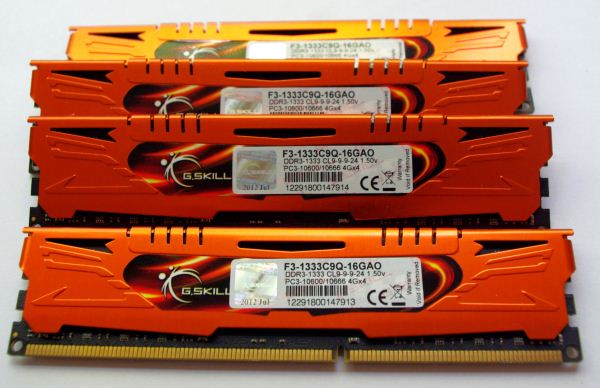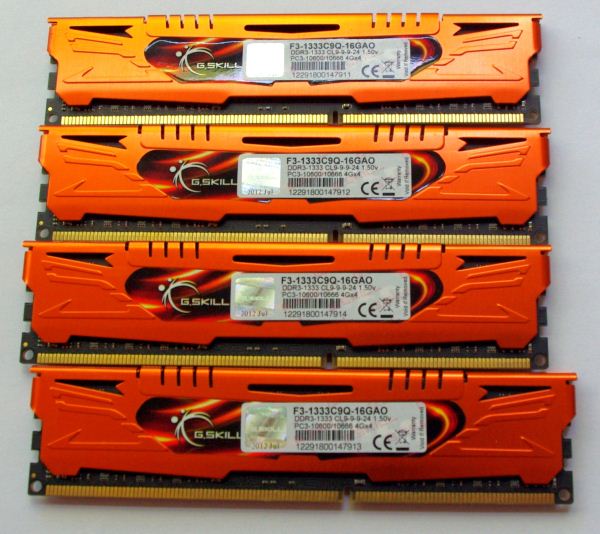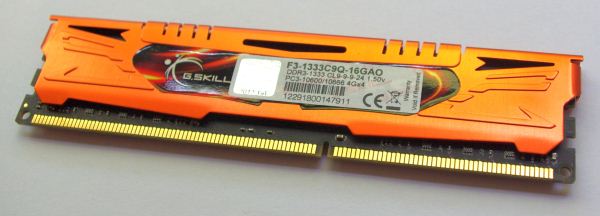Memory Performance: 16GB DDR3-1333 to DDR3-2400 on Ivy Bridge IGP with G.Skill
by Ian Cutress on October 18, 2012 12:00 PM EST- Posted in
- Memory
- G.Skill
- Ivy Bridge
- DDR3
At the lowest end of our testing, we have a 16GB DDR3-1333 9-9-9 kit on hand. When DDR3 was first released, the main speed available was DDR3-800, but enough time has passed that this has phased out and now 1333 MHz is the new ‘minimum’. With the prices of memory as they are, this kit from G.Skill currently retails for $75, meaning that a massive amount of memory is available for all at a reasonable level. To put this into contrast, I remember spending ~$240 on a 2x2 GB Kit of DDR2-800 5-5-5 about 5-6 years ago – we can now get four times the capacity for less than a third of the price.
DDR3-1333 sits at the bottom end, but within months we can imagine DDR3-1600 taking that spot – as we will see with the next kit, for $5 more we get a faster product.
Visual Inspection
Our first kit features G.Skill’s Ares branding – the Ares kits that G.Skill sell are essentially meant to be the lower profile but colored heatsinks. These heatsinks in all honesty may not be entirely necessary for cooling, but they are firmly bonded to the memory modules and removing them would be a large task and more than likely damage the module. I have seen horror stories of chips being removed along with the heatsink, making the memory unusable. As a result we cannot directly observe which ICs are being used in our kits for this review. A quick word in the ear of G.Skill and they will not tell us the information, under the guise that it is classified and if the competition wants to know what G.Skill are using, they will have to buy a kit and break it themselves. Given how small the margins are in memory sales (as well as potential market stagnation after the credit crisis), I’m not surprised with the level of secrecy.
Anyway, back to the kit:
The standard packaging at G.Skill is a rather efficient plastic container holding each of the modules. The packaging is easy enough to open, though I also found it fairly brittle, meaning small shards could break off and be easily lodged in feet. Inside the box itself is a piece of card to advertise the kit and protect the modules from each other. We also get a small G.Skill sticker for the computer case.
JEDEC + XMP Settings
| G.Skill | |||||
| Kit Speed | 1333 | 1600 | 1866 | 2133 | 2400 |
| Subtimings | 9-9-9-24 2T | 9-9-9-24 2T | 9-10-9-28 2T | 9-11-10-28 2T | 10-12-12-31 2T |
| Price | $75 | $80 | $95 | $130 | $145 |
| XMP | No | Yes | Yes | Yes | Yes |
| Size | 4 x 4 GB | 4 x 4 GB | 4 x 4 GB | 4 x 4 GB | 4 x 4 GB |
|
|
|||||
| MHz | 1333 | 1600 | 1867 | 2134 | 2401 |
| Voltage | 1.500 | 1.500 | 1.500 | 1.650 | 1.650 |
| tCL | 9 | 9 | 9 | 9 | 10 |
| tRCD | 9 | 9 | 10 | 11 | 12 |
| tRP | 9 | 9 | 9 | 10 | 12 |
| tRAS | 24 | 24 | 28 | 28 | 31 |
| tRC | 33 | 33 | 37 | 38 | 43 |
| tWR | 10 | 12 | 14 | 16 | 16 |
| tRRD | 4 | 5 | 5 | 6 | 7/6 |
| tRFC | 107 | 128 | 150 | 171 | 313 |
| tWTR | 5 | 6 | 8/7 | 9/8 | 10/9 |
| tRTP | 5 | 6 | 8/7 | 9/8 | 10/9 |
| tFAW | 20 | 24 | 24 | 25 | 26 |
| tCWL | - | 7 | 7 | 7 | 7 |
| CR | - | 2 | 2 | 2 | 2 |






















114 Comments
View All Comments
jwilliams4200 - Friday, October 19, 2012 - link
You are also incorrect, as well as highly misleading to anyone who cares about practical matters regarding DRAM latencies.Reasonable people are interested in, for example, the fact that reading all the bytes on a DRAM page takes significantly less time than reading the same number of bytes from random locations distributed throughout the DRAM module.
Reasonable people can easily understand someone calling that difference sequential and random read speeds.
Your argument is equivalent to saying that no, you did not shoot the guy, the gun shot him, and you are innocent. No reasonable person cares about such specious reasoning.
hsir - Friday, October 26, 2012 - link
jwilliams4200 is absolutely right.People who care about practical memory performance worry about the inherent non-uniformity in DRAM access latencies and the factors that prevent efficient DRAM bandwidth utilization. In other words, just row-cycle time (tRC) and the pin bandwidth numbers are not even remotely sufficient to speculate how your DRAM system will perform.
DRAM access latencies are also significantly impacted by the memory controller's scheduling policy - i.e. how it prioritizes one DRAM request over another. Row-hit maximization policies, write-draining parameters and access type (if this is a cpu/gpu/dma request) will all affect latencies and DRAM bandwidth utilization. So just sweeping everything under the carpet by saying that every access to DRAM takes the same amount of time is, well, just not right.
nafhan - Friday, October 19, 2012 - link
I was specifically responding to your incorrect definition of "random access". Randomness doesn't guarantee timing; it just means you can get to it out of order.jwilliams4200 - Friday, October 19, 2012 - link
And yet, by any practical definition, you are incorrect and the author is correct.For example, if you read (from RAM) 1GiB of data in sequential order of memory addresses, it will be significantly faster than if you read 1GiB of data, one byte at a time, from randomly selected memory addresses. The latter will usually take two to four times as long (or worse).
It is not unreasonable to refer to that as the difference between sequential and random reads.
Your argument reminds me of the little boy who, chastised by his mother for pulling the cat's tail, whined, "I didn't pull the cat's tail, I just held it and the cat pulled."
jwilliams4200 - Thursday, October 18, 2012 - link
Depending on whether there is a page-hit (row needed already open), page-empty (row needed not yet open), or page-miss (row needed is not the row already open), the time to read a word can vary by a factor of 3 times (i.e., 1x latency for a page-hit, 2x latency for a page-empty, and 3x latency for a page-miss).What the author refers to as a "sequential read" probably probably refers to reading from an already open page (page-hit).
While his terminology may be ambiguous (and his computation for the "sequential read" is incorrect, it should be 4 clocks), he is nevertheless talking about a meaningful concept related to variation on latency in DRAM for different types of reads.
See here for more detail:
http://www.anandtech.com/show/3851/everything-you-...
Shadow_k - Thursday, October 18, 2012 - link
My knowledge of RAM has increased 10 fold very nice artical well donelosttsol - Thursday, October 18, 2012 - link
2133MHz "Recommended for Deeper Pockets"???Not really. DDR3 is so cheap now that high end RAM is affordable for all. I would have said you were crazy a few years ago if you told me soon I could buy 16GB of RAM for less than $150.
IanCutress - Thursday, October 18, 2012 - link
Either pay $95 for 1866 C9 or $130 for 2133 C9 - minor differences, but $35 saving. This is strictly talking about the kits used today, there could be other price differences. But I stand by my recommendation - for the vast majority of cases 1866 C9 will be fine, and there is a minor performance gain in some scenarios with 2133 C9, but at a $35 difference it is hard to justify unless you have some spare budget. Most likely that budget could be put into a bigger SSD or GPU.Ian
just4U - Friday, October 19, 2012 - link
Something has to be said about the TridentX brand I believe.. since it is getting some pretty killer feedback. It's simply the best ram out there being able to do all that any other ram can and that little bit extra. I don't see the speed increase as a selling point but the lower timings at conventional speeds that users are reporting is interesting.. I haven't tried it though.. just going on what I've read. Shame about the size of the heatsinks though.. makes it problematic in some builds.Peanutsrevenge - Friday, October 19, 2012 - link
You clearly live in some protected bubble where everyone has well paid jobs and isn't on a shoestring budget.I would so LMAO when you get mugged by someone struggling to feed themselves because you're all flash with your cash.